For the 2025 school year, there is 1 public high school serving 277 students in Abingdon-Avon CUSD 276 School District. This district's average high testing ranking is 1/10, which is in the bottom 50% of public high schools in Illinois.
Public High School in Abingdon-Avon CUSD 276 School District have an average math proficiency score of 8% (versus the Illinois public high school average of 28%), and reading proficiency score of 15% (versus the 29% statewide average).
Public High School in Abingdon-Avon CUSD 276 School District have a Graduation Rate of 87%, which is equal to the Illinois average of 87%.
The school with highest graduation rate is Abingdon-avon High School, with 85-89% graduation rate. Read more about public school graduation rate statistics in Illinois or national school graduation rate statistics.
Minority enrollment is 11% of the student body (majority Hispanic), which is less than the Illinois public high school average of 55% (majority Hispanic).
Overview
This School District
This State (IL)
# Schools
3 Schools
1,032 Schools
# Students
708 Students
605,599 Students
# Teachers
60 Teachers
42,722 Teachers
Student : Teacher Ratio
12:1
12:1
District Rank
Abingdon-Avon CUSD 276 School District, which is ranked within the bottom 50% of all 844 school districts in Illinois (based off of combined math and reading proficiency testing data) for the 2020-2021 school year.
The school district's graduation rate of 85-89% has increased from 80-84% over five school years.
Overall District Rank
#576 out of 852 school districts
(Bottom 50%)
(Bottom 50%)
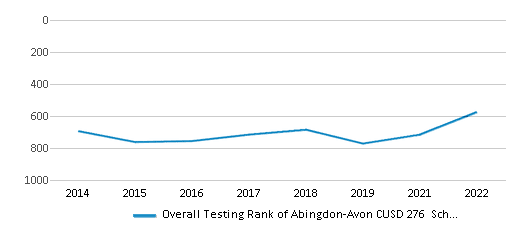
Math Test Scores (% Proficient)
(20-21)12%
28%
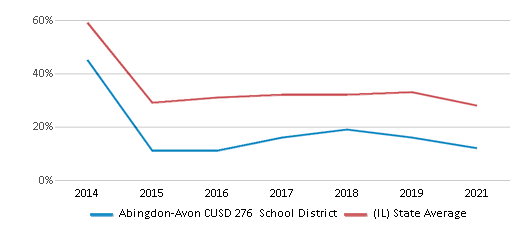
Reading/Language Arts Test Scores (% Proficient)
27%
30%
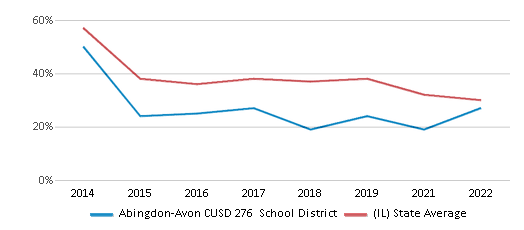
Science Test Scores (% Proficient)
40-44%
50%
Graduation Rate
85-89%
87%

Students by Ethnicity:
Diversity Score
0.24
0.69
# American Indian Students
2 Students
1,567 Students
% American Indian Students
n/a
n/a
# Asian Students
1 Student
32,853 Students
% Asian Students
n/a
6%
# Hispanic Students
35 Students
175,467 Students
% Hispanic Students
5%
29%
# Black Students
13 Students
98,861 Students
% Black Students
2%
16%
# White Students
617 Students
273,633 Students
% White Students
87%
45%
# Hawaiian Students
n/a
637 Students
% Hawaiian Students
n/a
n/a
# Two or more races Students
40 Students
22,148 Students
% of Two or more races Students
6%
4%
Students by Grade:
# Students in PK Grade:
63
85
# Students in K Grade:
59
405
# Students in 1st Grade:
76
432
# Students in 2nd Grade:
53
440
# Students in 3rd Grade:
61
538
# Students in 4th Grade:
63
557
# Students in 5th Grade:
56
763
# Students in 6th Grade:
-
1,672
# Students in 7th Grade:
-
4,432
# Students in 8th Grade:
-
4,914
# Students in 9th Grade:
68
149,389
# Students in 10th Grade:
69
150,473
# Students in 11th Grade:
70
146,807
# Students in 12th Grade:
70
144,692
# Ungraded Students:
-
-
District Revenue and Spending
The revenue/student of $22,275 is higher than the state median of $21,990. The school district revenue/student has grown by 32% over four school years.
The school district's spending/student of $19,767 is less than the state median of $21,244. The school district spending/student has grown by 32% over four school years.
Total Revenue
$16 MM
$41,381 MM
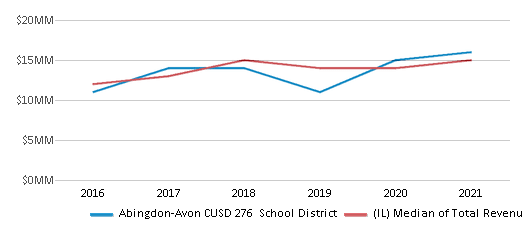
Spending
$14 MM
$39,976 MM
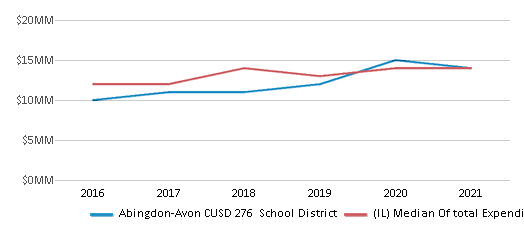
Revenue / Student
$22,275
$21,990
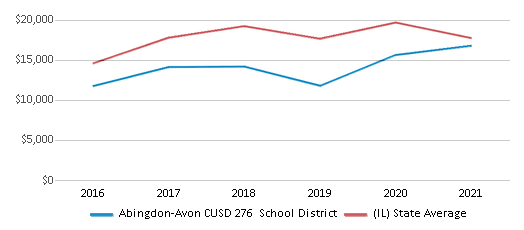
Spending / Student
$19,767
$21,244
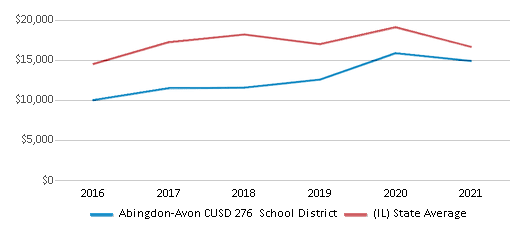
Best Abingdon-Avon CUSD 276 School District Public High Schools (2025)
School
(Math and Reading Proficiency)
(Math and Reading Proficiency)
Location
Grades
Students
Rank: #11.
Abingdon-avon High School
Rank:
3/
Bottom 50%10
600 W Martin St
Abingdon, IL 61410
(309) 462-2338
Abingdon, IL 61410
(309) 462-2338
Grades: 9-12
| 277 students
Recent Articles

Year-Round Or Traditional Schedule?
Which is more appropriate for your child? A year-round attendance schedule or traditional schedule? We look at the pros and cons.

Why You Should Encourage Your Child to Join a Sports Team
Participating in team sports has a great many benefits for children, there is no doubt. In this article you will learn what those benefits are.

White Students are Now the Minority in U.S. Public Schools
Increasing birth rates among immigrant families from Asia and Central and South America, combined with lower birth rates among white families, means that for the first time in history, public school students in the United States are majority-minority. This shift in demographics poses difficulties for schools as they work to accommodate children of varying language abilities and socio-economic backgrounds.





